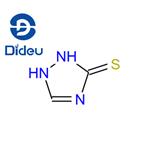Application research of 1H-1,2,4-triazole-3-thiol
Introduction
1H-1,2,4-triazole-3-thiol is a white or off white powder (Figure 1). It has low solubility in water and most organic solvents, but has some solubility in alcohols or ketones. 1H-1,2,4-triazole-3-thiol is relatively stable at room temperature and pressure, but should avoid contact with strong oxidants, strong acids, and strong bases to prevent chemical reactions. Due to the presence of thiol groups, it may have certain toxicity, and appropriate protective measures should be taken during operation. 1H-1,2,4-triazole-3-thiol is widely used in the pharmaceutical, photographic, and additive industries, and is an important chemical intermediate. For example, the use of 1H-1,2,4-triazole-3-thiol has led to a rare inorganic-organic hybrid supramolecular nanotube built from novel Ni5-substituted polyoxotungstates, which presents interesting structural characteristics, high chemical stability, and proton-conducting properties.[1]

1.Voltammetric determination and electrochemical behavior of vanillin based on 1H-1,2,4-triazole-3-thiol polymer film modified gold electrode
In this current work, the electropolymerization of 1H-1,2,4-triazole3-thiol (T3T) on the Au electrode surface was performed using thecyclic voltammetry (CV) technique. Besides, the CV technique was usedto characterize the T3T-Au modified electrode. A simple, sensitive, andrapid approach was developed for the successful determination of VAN.The analytical performance of the modified electrode was tested on areal sample such as the sugared vanilla and coffee samples with satisfactory results.
Poly(1H-1,2,4-triazole-3-thiol) conductive film was coated successfully on the gold electrode (Au).The electrochemical behavior of vanillin (VAN) was studied on the 1H-1,2,4-triazole-3-thiol-Au (T3T-Au)electrode. The determination of VAN was performed on the T3T-Au electrode using a differential pulse voltammetry (DPV) technique. In order to detect the concentration of VAN, suitable supporting electrolyte solution and pH value were determined. At pH 3 in HClO4 solution, the anodic peak current of VAN obtained with theT3T-Au electrode is 4.3 times greater than the bare Au electrode. The response oxidation peak current and concentration of VAN showed a good linear relationship in the range of 0.1-11.3 µM. The limit of detection was found as 0.04 µM. Besides, the reproducibility, repeatability, stability, and interference measurements were also assayed. This sensor was applied successfully for the detection of VAN in synthetic samples and various food samples.[2]
2.Regulating the Heme Active Site by Covalent Modifications: Two Case Studies of Myoglobin
Using myoglobin (Mb) as a model protein, the authors herein developed a facial approach to modifying the heme active site. A cavity was first generated in the heme distal site by F46 C mutation,and the thiol group of Cys46 was then used for covalently linked to exogenous ligands, 1H-1,2,4-triazole-3-thiol and 1-(4-hydroxyphenyl)-1H-pyrrole-2,5-dione. The engineered proteins,termed F46C-triazole Mb and F46C-phenol Mb, respectively,were characterized by X-ray crystallography, spectroscopic and stopped-flow kinetic studies. The results showed that both the heme coordination state and the protein function such as H2O2activation and peroxidase activity could be efficiently regulated,which suggests that this approach might be generally applied to the design of functional heme proteins.[3]
3. Chemically Bonded Plasmonic Triazole-Functionalized Au/Zeolitic Imidazole Framework (ZIF-67) for Enhanced CO2 Photoreduction
The design of functionalized metallic nanoparticles is considered an emerging technique to ensure the interaction between metal and semiconductor material. In the literature, this interface interaction is mainly governed by electrostatic or van der Waals forces, limiting the injection of electrons under light irradiation. To enhance the transfer of electrons between two compounds, close contact or chemical bonding at the interface is required. Herein, a new approach was reported for the synthesis of chemically bonded plasmonic Au NPs/ZIF-67 nanocomposites. The structure of ZIF-67 was grown on the surface of functionalized plasmonic Au NPs using 1H-1,2,4-triazole-3-thiol as the capping agent, which acted as both stabilizer of Au nanoparticles and a molecular linker for ZIF-67 formation. As a result, the synthesized material exhibited outstanding photocatalytic CO2 reduction with a methanol production rate of 2.70 mmolh-1g-1cat under sunlight irradiation. This work emphasizes that the diligent use of capping agents, with suitable functional groups, could facilitate the formation of intimate heterostructure for enhanced photocatalytic CO2 reduction.[4]
References
[1] Cao GJ, Liu JD, Zhuang TT, Cai XH, Zheng ST. A polyoxometalate-organic supramolecular nanotube with high chemical stability and proton-conducting properties. Chem Commun (Camb). 2015;51(11):2048-2051. doi:10.1039/c4cc08445d
[2] Tabanlıgil Calam T. Voltammetric determination and electrochemical behavior of vanillin based on 1H-1,2,4-triazole-3-thiol polymer film modified gold electrode. Food Chem. 2020;328:127098. doi:10.1016/j.foodchem.2020.127098
[3] Chen ZY, Yuan H, Wang H, et al. Regulating the Heme Active Site by Covalent Modifications: Two Case Studies of Myoglobin. Chembiochem. 2024;25(3):e202300678. doi:10.1002/cbic.202300678
[4] Becerra J, Nguyen DT, Nair Gopalakrishnan V, Do TO. Chemically Bonded Plasmonic Triazole-Functionalized Au/Zeolitic Imidazole Framework (ZIF-67) for Enhanced CO2 Photoreduction. ChemSusChem. 2022;15(21):e202201535. doi:10.1002/cssc.202201535
You may like
See also
Lastest Price from 1H-1,2,4-Triazole-3-thiol manufacturers

US $0.00/kg2025-11-18
- CAS:
- 3179-31-5
- Min. Order:
- 1kg
- Purity:
- 98%
- Supply Ability:
- 1000kgs

US $0.00/Kg/Drum2025-04-21
- CAS:
- 3179-31-5
- Min. Order:
- 1KG
- Purity:
- 99%min
- Supply Ability:
- 1000kgs


